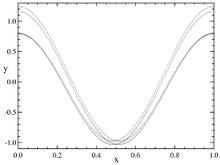Kaplan–Yorke map
From Wikipedia, the free encyclopedia

A plot of 100,000 iterations of the Kaplan-Yorke map with α=0.2. The initial value (x0,y0) was (128873/350377,0.667751).
The Kaplan–Yorke map is a discrete-time dynamical system. It is an example of a dynamical system that exhibits chaotic behavior. The Kaplan–Yorke map takes a point (xn, yn ) in the plane and maps it to a new point given by
where mod is the modulo operator with real arguments. The map depends on only the one constant α.
Calculation method
Due to roundoff error, successive applications of the modulo operator will yield zero after some ten or twenty iterations when implemented as a floating point operation on a computer. It is better to implement the following equivalent algorithm:
where the  and
and  are computational integers. It is also best to choose
are computational integers. It is also best to choose  to be a large prime number in order to get many different values of
to be a large prime number in order to get many different values of  .
.
References
- J.L. Kaplan and J.A. Yorke (1979). H.O. Peitgen and H.O. Walther, ed. Functional Differential Equations and Approximations of Fixed Points (Lecture notes in Mathematics 730). Springer-Verlag. ISBN 0-387-09518-7.
- P. Grassberger and I. Procaccia (1983). "Measuring the strangeness of strange attractors". Physica 9D (1-2): 189–208. Bibcode:1983PhyD....9..189G. doi:10.1016/0167-2789(83)90298-1.
This article is issued from Wikipedia. The text is available under the Creative Commons Attribution/Share Alike; additional terms may apply for the media files.



